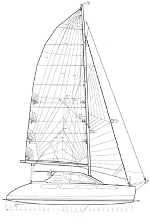Hughs 46
Cruising Multihullr
Let's start our comparison with the basic hull shapes. The overall beam of the Hughs cat is 28 feet, 11 inches while the Novara is 31 feet, 6 inches. Both share almost identical sectional shapes with flaring out above the DWL and double-chine topsides to increase useable interior volume. Where they really diverge is in the sectional shape below the DWL. The Novara has no deadrise at all. Its midsection appears almost arclike and goes tangent at centerline. Kurt's cat has a deadrise angle amidships of 8 degrees.
Have I lost you? Well, consider deadrise as the angle the section makes with the centerline measured off horizontal. A V-bottom boat has deadrise. A flat-bottomed boat has no deadrise. I have no idea at all what the etymological origins of this term are. A boat with rounded sections and no distinct "corner" or "crease" running down the centerline has no deadrise, and I call this "going tangent" as it makes a tangent with a horizontal line at centerline.
The four hulls tank-tested by Novara were all without deadrise. It would seem given the dramatic difference in sectional shapes here that one designer is "right" and the other is "wrong." Maybe. I look at it this way. Since you drag your hull through the water most of the time with a yaw angle due to leeway it doesn't make much sense to drag a corner through the water. The vortex off that corner will just create drag. Double that drag for a cat. It's far better to just let the water from the high pressure side of the hull slide over effortlessly to the low pressure side. At high, planing speeds the flatter bottom will also help the boat get up on a plane quicker. For a cruising boat, deadrise is a strong shape that adds longitudinal stiffness and creates a natural sump to gather any bilge water that might accumulate. I suppose you could also argue that in a boat with minimal append-ages the corner of the deadrise hull will help the boat go to weather by minimizing leeway. But I'd rather see less deadrise or none at all and better boards.
This cat weighs 18,603 pounds and has a D/L of 91.14. Kurt provided a well prepared and highly documented weight study to verify this weight. You can have either fixed low-aspect-ratio keels or you can have lifting daggerboards. You will get about half the lift with the keels while incurring about the same drag. Keels will be cheaper to build and require less maintenance.
This is a well-styled boat. Given Kurt's statement about shoving a house through the water you can imagine that he considers windage very important in the design of a cruising cat.
The interior is similar to the Novara in that this cat has three staterooms. The big difference is that this cat has a deckhouse, and the dinette, lounging area and nav station are all in this structure. There is even an inside steering station in this deckhouse. The galley is tucked all the way aft in the port hull. I don't like this, since it means you have to do your cooking down a level from the dining area, five steps down to be exact, and fairly steep steps at that. I would worry about the new potatoes and parsnips rolling off the platter as I made my way up from the galley carrying the roast. You just couldn't do it. Am I being picky? No, I think this is a serious shortcoming of this design. Having said that I'm quite certain that this was probably a client-driven feature. For me, I'd want the galley on the same level as the dining area and much closer to the cockpit. There is a shower/tub in the starboard, forward stateroom.
Kurt's an old hand with multihulls. His designs have been built all over the world. This new cat appears to provide the comfort advantages offered by cat proportions with the performance benefits of modern multihull design.

Comments